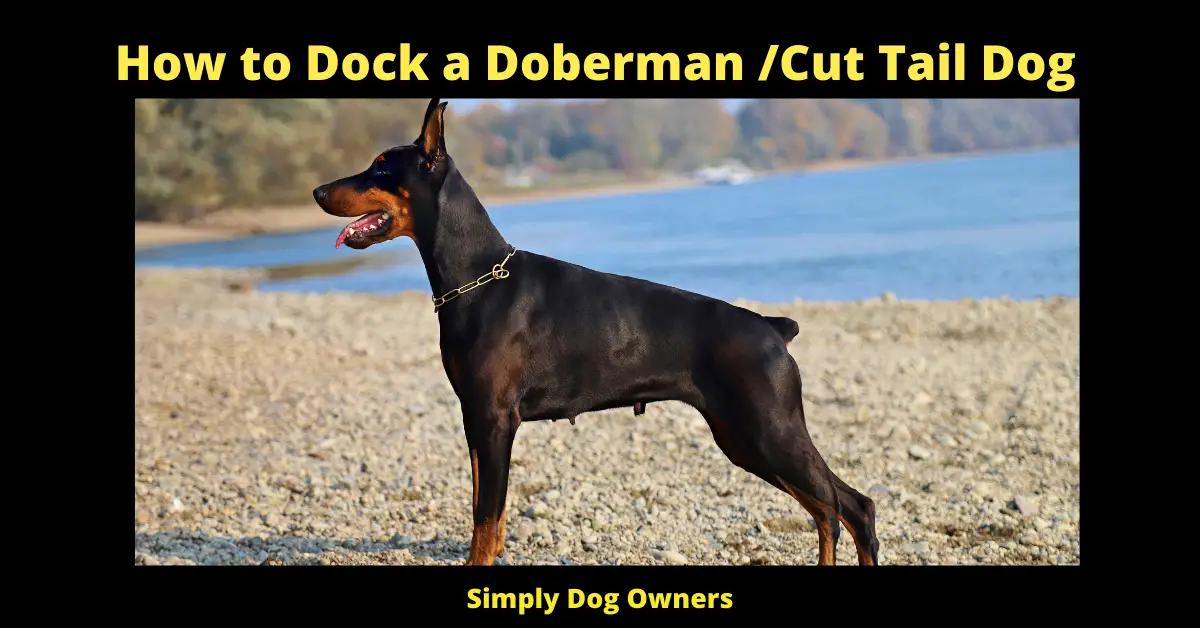How to Cut a Doberman Tail – Doberman with Long Tail
Tail docking or cutting a dog’s tail is a common occurrence for a variety of reasons. Whether the dog has an infection in its tail, is injured and requires healing, or was born with a long tail, docking can be accomplished in various ways. Doberman pinschers are born with floppy ears and long tails, resembling labradors or hound dogs. Cropping the dog’s ear and docking the tails results in the upright standing ear and short tail.
Tail docking in dogs can be performed in one of two ways by veterinarians and breeders. They’ll either “band” the tail, cutting off circulation to the area until it falls off on its own, or they’ll remove it surgically. Alternatively, they’ll sever the tail docking in dogs with a sharp instrument such as a scalpel or scissors, severing muscle tissue, cartilage, the spinal column, and nerve endings.
Typically, veterinarians and breeders perform this procedure without anesthesia or sutures. Suturing is occasionally necessary in larger dogs or cases of excessive bleeding. We’ll compare the advantages of trimming Dobermans’ tails at home versus bringing them to a veterinarian clinic.
Why do they Cut Dog Tails?
Nowadays, people remove the tails of Dobermans for four primary reasons: to conform to breed standards, for sanitary reasons, to protect the dog from injury, and for cosmetic reasons.
Breeders of purebred dogs frequently undergo these surgical modifications to maintain compliance with AKC standards. The AKC requires tail docking for over 60 breeds or nearly a third of the breeds on the registry. Animal activists emphasize that the AKC breed standards promote this antiquated practice by refusing undocked dogs to compete in shows.
Few pet parents prefer to dock long-haired dogs to prevent a buildup of fecal matter on the dogs’ hind end, which reduces the likelihood of matting and makes cleanup easier.
Others choose to remove the tails of working breeds to prevent briars and burrs from becoming embedded in the fur and injuring the animal. Others clip dogs’ seats for the same reason for cropped ears: they like how it looks. Doberman with Long Tail
- Doberman Breed Standard
- Cosmetic Reasons
- Working Dog ( Search & Rescue )
- Protection Animals
- Done Young – Harder when Dog is Older
Steps how to Dock a Dog’s Tail/Tail Docking Procedure
The amount of tail docked during a tail docking procedure is determined by the breed standard for that dog breed. Generally, the remaining tail segment is between 14 and 14 inches in length (for a Norwich terrier, for example) (for a giant schnauzer).
A scalpel can be used to separate the bones in the tail during surgery. Suture material can then be used to close the small incision. Additionally, laser surgery or electrosurgery are options. In some instances, however, a constricting band is used.
Tail docking is typically performed on puppies between the ages of three and five days. Local anesthesia is used for numbing the area before surgery, but it is not always necessary.
If surgery is not performed before the dog is five days old, it should be delayed until it is between eight and twelve weeks old. If surgery is performed at that time, general anesthesia is recommended.
When performing medical caudectomy on an adult dog, general anesthesia is used. The extent to which the tail is removed is determined by the medical condition being treated.

What is the Best dog Tail Docking Age?
Between three and five days of age, puppies have their docked tail. They are still in their infancy at that point, and their nervous systems are not fully developed.
Anesthesia is not used at this age, nor would it be safe in a dog this young. Tail docking produces the best aesthetic results when performed at a young age. After the nervous system development window has closed, puppies having their tails docked will be sedated and charged as “adults.” Additionally, adult dogs can have their tails docked. Adults undergo the procedure under complete anesthesia, which is more expensive.
Are Dobermans Born with Short Tails?
Although the Doberman is most frequently seen with a short tail, it is born with a longer tail than the tails of many other breeds. Typically, a Doberman Pinscher is docked or has most of its docked tail within days of birth.
Benefits of docking a dog’s tail?
A frequent reason for tail docking is to prevent injury. It is critical to note that this assertion is supported by scant scientific evidence. The most extensive study on the subject (500 dogs) discovered a 0.23 percent incidence of tail injury in dogs with natural tails, implying that over 500 dogs would need to undergo the tail docking procedure to avoid a single tail injury.
Another frequently cited reason is the cleanliness of long-haired breeds. While this is partially true, a haircut is often sufficient. Certain breeds of dogs are capable of clearing a coffee table with their tail. Surgery may be considered if a tail is injured or becomes a hazard to others, but tail docking is often done solely for aesthetic reasons.
Is Tail Docking Dogs Painful?
Tail docking proponents assert that it causes no pain or discomfort because puppies’ nervous systems are not fully developed. This is not the case; a dog’s nervous system as a whole is fully developed at birth. Puppies, it appears, have a similar sensitivity to pain as adult dogs. Docking a puppy’s tail entails severing muscles, tendons, and up to seven pairs of susceptible nerves, as well as cutting through bone and cartilage connections.
Tail docking is typically performed without an anesthetic or analgesia (pain relief). Puppies make repeated, intense shrieking vocalizations when the tail is cut off, and the wound is stitched, indicating that they are in significant pain. Inflammation and tissue damage also contribute to ongoing pain while the wound heals. Additionally, this unnecessary surgery carries the risk of infection or other complications.
Additionally, tail docking can cause unnecessary and avoidable long-term chronic pain and distress in docked dogs. For instance, when a chronic neuroma develops at the site of amputation. Neuromas are frequently excruciatingly tail docking painful.
Are Dogs Sedated for Tail Docking?
Puppies younger than eight days are either given a local anesthetic or are not given any anesthesia. If the puppy is more than eight days old, many veterinarians will postpone the procedure until the puppy is eight weeks old. General anesthesia is required at that point to induce unconsciousness, complete pain control, and muscle relaxation.
In case if general anesthesia is used, the pet may receive a pre-anesthetic sedative-analgesic medication to aid in relaxation, a brief intravenous anesthetic to facilitate the placement of a breathing tube in the windpipe, and then inhalation (gas) anesthesia in oxygen during the actual surgery.

What Is the Typical Postoperative Care?
Daily suture line monitoring is a critical aspect of home care. Keep an eye out for redness, discharge, swelling, or pain. The puppy can be immediately returned to his mother. Keep an eye out for excessive grooming of the surgical site by the mother.
Any bandage applied should be removed within two to three days. Additionally, sutures may need to be removed, mainly if the procedure was performed on an older animal. Sutures that are not absorbable are removed 5 to 7 days after surgery.
What States is it Illegal to Dock a Dog’s Tail?
Several countries, including Sweden, Norway, the Netherlands, Finland, Germany, and Denmark, have prohibited cosmetic tail docking. Additionally, several European countries, including Cyprus, Greece, Luxembourg, Switzerland, and Austria, have ratified a European Convention prohibiting cosmetic tail docking.
Tail docking is not permitted in the United Kingdom unless performed by a registered veterinary surgeon. The Royal College of Veterinary Surgeons opposes the practice, describing it as ‘unacceptable mutilation.
Care after Tail Docking?
Because tail docking is typically performed on puppies just before being sold or adopted, pet owners are rarely required to provide any care.
If the tail docking procedure is performed on an older puppy (between 8 and 12 weeks of age), a suture may still be present at the time of purchase or adoption. If this is the case, the puppy should be restrained from licking the area until completely healed.
Like the previous example, littermates or the dam may attempt to lick the area, which should be avoided. Notify your veterinarian immediately if any swelling, discharge, or discoloration of the area is observed.

Sutures are likely to be present, or the area may be bandaged to keep it clean in older pets undergoing caudectomy for medical reasons. Sutures should be checked for bleeding, swelling, or discharge regularly if they are present. If a bandage is present, it needs to be checked for moisture, slippage, or soiling frequently.
An Elizabethan collar is necessary if the pet attempts to lick the area. This cone-shaped collar fits comfortably over the pet’s head and restricts access to the pet’s rear end. If necessary, your veterinarian can fit your pet with the proper-sized collar.
Final Thoughts – Doberman with Long Tail
Tail docking is a surgical procedure that involves the removal of a portion of the dog’s tail. This procedure is most frequently performed on healthy puppies. A similar procedure may be performed in older pets, but this is referred to as a tail amputation, not a tail dock. Tail docking is most frequently performed on puppies to prevent tail damage in certain dog breeds, as a matter of hygiene, and conform to specific breed standards.
